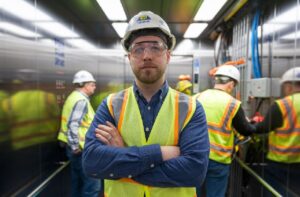Want to Breathe Easy in Elevators? Elevate Hygiene Standards with Hepa-Elevators
An Innovative Leap in Elevator Sanitation
Imagine the peace of mind that comes with knowing that each time you enter an elevator, the air is clean and every surface is sanitized. As we prioritize health and safety in every aspect of modern life, ensuring that even brief, enclosed spaces such as elevators are free from contaminants has become essential. Enter the Hepa-Type Disinfection System, an advanced sanitation solution specifically crafted to address the complex challenges of elevator hygiene. This trailblazing technology promises not only cleaner air but also unparalleled levels of safety and tranquility.
Why Elevator Hygiene Matters More Than Ever
Elevators, the beating heart of high-rise buildings, play a vital role in urban living, yet they are often overlooked in public health discussions. Many people use elevators on a daily basis, which makes them particularly vulnerable to the spread of germs, viruses, and bacteria. This rate is higher in hospitals, office buildings, hotels, and other high-traffic environments where the flow of people is constant. Unlike spacious rooms, elevators are confined and constantly re-occupied, making conventional cleaning efforts largely ineffective in providing consistent cleanliness.
As cities grow taller and more densely populated, the demand for vertical transportation continues to surge. But how safe is the air we’re breathing during these brief but frequent elevator rides? Traditional cleaning efforts can only go so far in addressing such a compact, high-touch environment. The Hepa-Type Disinfection System takes elevator cleanliness to an unprecedented level, addressing these health concerns in real-time with technology that captures, neutralizes, and prevents pathogens, thus transforming the very concept of elevator sanitation.

How Hepa-Type Disinfection Systems Revolutionize Elevator Hygiene
Equipped with powerful HEPA filters and ultraviolet (UV-C) light technology, Hepa-Type Disinfection Systems employ a multi-pronged approach to sanitize both the air and surfaces within the elevator cabin. Here’s a closer look at how this cutting-edge technology works to keep elevators as safe as possible:
- Advanced HEPA Filtration: At the heart of the system is a high-efficiency particulate air (HEPA) filter, a technology proven to capture 99.97% of airborne particles, including viruses, bacteria, and pollutants as small as 0.3 microns. Each time the elevator moves, the system continuously filters and purifies the air, eliminating contaminants before they can linger. This process is especially critical in elevators where the same air is often recirculated, amplifying the importance of a filtration system that works continuously and effectively.
- UV-C Surface Sterilization: Hepa-Type Disinfection Systems tackle surface contamination by integrating UV-C light technology—a wavelength proven to disrupt the DNA of bacteria and viruses, effectively neutralizing them. Whenever the elevator is vacant, the system initiates an automatic surface sterilization cycle, eradicating any pathogens that may have accumulated on buttons, walls, or handrails. This two-part approach to cleaning both the air and surfaces sets a new standard for elevator hygiene, providing a level of cleanliness that few systems can match.
- Invisible Air Curtains for Added Protection: One of the most innovative features of Hepa-Type Disinfection Systems is the creation of invisible air curtains within the elevator cabin. These air curtains act as shields, minimizing the risk of cross-contamination between passengers by compartmentalizing airflow. This smart design feature adds extra safety by creating a shield against germs that other people might bring in, especially in busy areas.
- Automatic Sterilization Mode: Unlike traditional cleaning methods that rely on human intervention, Hepa-Type Disinfection Systems work autonomously. When the elevator is vacant, the system activates an intensive sterilization mode that goes beyond regular sanitization to eliminate any lingering microbial threats. This feature is especially useful for busy buildings, where ensuring the elevator is clean after every ride would otherwise be impractical.
Additional Features for Optimal Installation
Hepa-Type Disinfection Systems can be tailored to fit various elevator models, ensuring compatibility with both new installations and retrofitted upgrades. For buildings where space constraints may be a concern, modular options, such as compact HEPA filters and UV-C lights can be easily integrated. These customizable options make it possible for different building types to benefit from this advanced technology without extensive renovations or alterations. Additionally, ventilation fans with HEPA filters and UV-C disinfection systems are available for seamless integration, allowing buildings to enhance indoor air quality without sacrificing efficiency or space.
The Multifaceted Benefits of Hepa-Elevators Disinfection Systems
Integrating Hepa-Type Disinfection Systems into elevators offers an array of benefits that extend far beyond just clean air. This technology represents a holistic approach to health and well-being in public spaces, with advantages that impact building managers, occupants, and the general public alike.
- Significantly Enhanced Hygiene: By continuously purifying the air and surfaces, Hepa-Type Disinfection Systems reduce the risk of disease transmission in high-traffic areas. From hospitals to office buildings, this added layer of cleanliness is invaluable in maintaining a healthy indoor environment.
- Greater Peace of Mind for Occupants: In an era where public health concerns are at an all-time high, the presence of advanced hygiene technology in elevators provides reassurance for passengers. Knowing that rigorous measures are in place allows people to use shared spaces with confidence, enhancing their overall experience in the building.
- Supports Broader Public Health Initiatives: The installation of Hepa-Type Disinfection Systems aligns with broader public health goals by minimizing the spread of infectious diseases. As a proactive measure, it serves as an example of how buildings can take responsibility for occupant safety in innovative and impactful ways.
- Reduces Odors for a More Pleasant Experience: While the primary goal of the system is to sanitize, its ability to capture airborne particles and neutralize odor-causing molecules also helps maintain a fresher atmosphere. For elevators in residential buildings, hotels, or shopping centers, this feature contributes to a more enjoyable ride.
- Long-Term Cost Savings: Although the initial investment in Hepa-Type Disinfection Systems may be higher than traditional methods, the long-term benefits often outweigh the costs. Reducing the spread of illness not only lowers absenteeism but also improves public perception, making the technology a worthwhile investment for property owners.
Frequently Asked Questions (FAQ)
Q: Are Hepa-Type Disinfection Systems safe for regular use in elevators?
Ans: Yes, these systems are designed with user safety as a top priority. HEPA filters and UV-C light technology are rigorously tested to ensure that they are effective without posing any harm to elevator passengers. Both technologies operate within safe parameters, providing robust protection without compromising health.
Q: How often should Hepa-Type Disinfection Systems be maintained?
Ans: Maintenance schedules for Hepa-Type Disinfection Systems vary based on factors like usage and environmental conditions. However, it is generally recommended that filters be replaced and UV-C bulbs inspected regularly to ensure optimal performance. This proactive approach ensures that the system remains effective over time.
Q: Can existing elevators be retrofitted with Hepa-Elevators Disinfection Systems?
Ans: Absolutely. Hepa-Elevator Disinfection Systems are designed for adaptability and can be installed in most existing elevator cabins with minimal disruption. Professional installation teams are available to assess each elevator’s compatibility, providing solutions that meet specific needs.
Q: Do these systems help reduce odors in elevators?
Ans: Yes. While odor control is not the primary function, Hepa-Elevators Disinfection Systems contribute to a cleaner and more pleasant environment by capturing airborne particles and neutralizing odor-causing agents.
Q: Are Hepa-Elevator Disinfection Systems cost-effective in the long run?
Ans: Over time, the investment in Hepa-Type Disinfection Systems proves to be cost-effective by enhancing public health, reducing illness transmission, and improving building reputation. The long-term benefits make these systems a valuable addition to any property.
Conclusion
As we seek to create healthier, safer spaces in a post-pandemic world, Hepa-Type Disinfection Systems offer an unparalleled solution to the challenges of elevator hygiene. By seamlessly integrating advanced HEPA filtration, UV-C surface sterilization, and innovative air curtain technology, these systems set a new standard in public sanitation. With benefits that include improved hygiene, peace of mind, and support for public health, the Hepa-Type Disinfection System is more than a simple upgrade—it’s a transformative step toward a safer and cleaner future.
Imagine a world where every elevator ride brings peace of mind, where indoor air quality is prioritized, and where even the smallest spaces are safeguarded against invisible threats. With Hepa-Elevators Disinfection Systems, this vision is closer than ever, providing an inspiring model for health-focused innovation in shared spaces. Embrace the future of elevator hygiene with Hepa-Type Disinfection Systems and breathe easy, knowing that your journey is protected.
For hepa installation, you can check with Premier Elevator Cabs.
Read more about the advanced elevator solution by clicking here.
.





Pingback: Streamlining Hospital Elevator Use